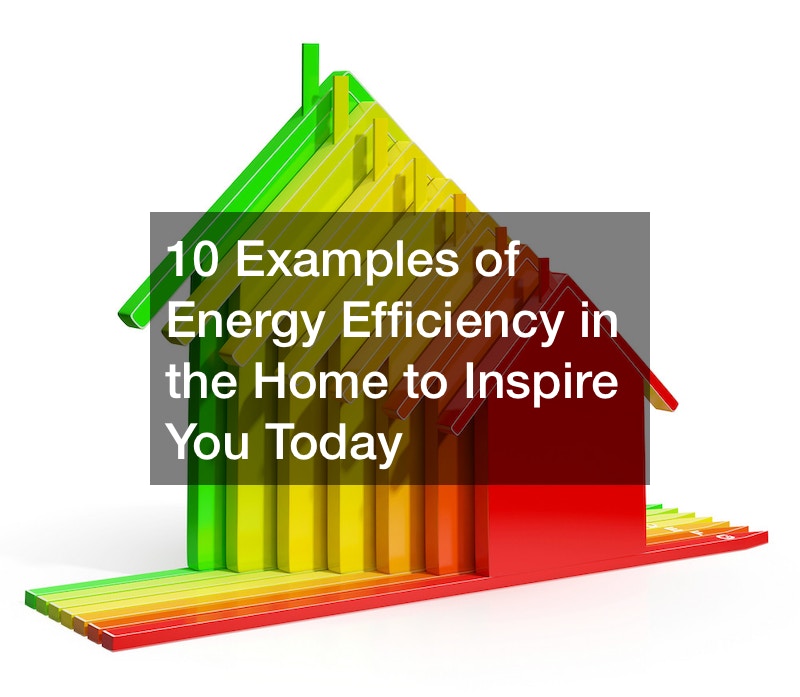
Modern homes, especially in warm climates like Texas and Arizona, can lead to costly energy bills over time. Additionally, many things in the modern world are becoming more energy-efficient and by making small changes you can make a huge impact on your family’s energy bills. Here are 10 examples of energy-efficient improvements you can consider for your home.
1. Energy-Efficient Roofing Materials
There are several ways to improve a roof’s energy efficiency. Building a cool roof that isn’t tiled and using a cool roof system would be one way. Another is to use lightweight roof materials that aren’t widely available today. You can also install insulation in the roof’s attic spaces. While roof insulation is more expensive than a roof replacement, it can greatly improve energy efficiency and lessen the building’s energy load. This will decrease the roof’s utility bill and lower the building’s greenhouse gas emissions. This can also be done with energy-efficient asphalt roofing services.
Another environmentally-friendly way to increase roof energy efficiency is to use “cold-black” roof coating. This coating is highly energy-efficient because it reflects away much of the heat that occurs on a roof and dissipates it to the exterior or else to the ground. Cold-black roof coating is also environmentally-friendly because it’s non-toxic and has no harmful materials, chemicals, or pigments. A combination of adding an energy-efficient roof system and cool roof coatings can help reduce the building’s energy bill.
2. Effective Insulation

There are easy ways to lower your energy costs without breaking the bank. The structure of a modern home greatly affects its energy efficiency. Light and heat gain in modern structures are so large that any of the draftiest rooms in the house could lead to excessive heating and cooling costs.
Saving energy means lowering the amount of heat that comes into the house. Replacing old drafty areas with highly-efficient insulation is a huge step in the right direction. One way to determine the right type of insulation is to measure the air pressure around every wall in the home. Once you get a good idea of the air pressure around the outside of the house, you’ll have a good idea of the type of insulation that will make the biggest impact.
Custom home energy improvements make welcome upgrades to homes. This can be both good and bad for the environment. However, there are ways to make the process affordable and even low-cost.
3. Durable or Recyclable Siding
Many people choose to live in their homes for many years, so it would be a shame if the air, water, and other components were damaged or compromised. Recycling and making a conscious effort to be more energy-efficient doesn’t have to be difficult, especially when you start by taking the time to recycle your existing home.
Save energy and money in your home by recycling your old siding and building a new home. It’s really easy to understand why someone would want to build a new home when the one you’re living in now is old and drafty. Yet the truth is, there are real benefits and drawbacks to insulating your home’s exterior.
One key benefit of insulating your exterior is reducing your air pressure, which in turn reduces your energy consumption and makes your home more energy-efficient.
Additionally, you may consider insulating your exterior siding to lower your heating and cooling bills. It sounds like a win-win situation, right? Well, there’s a chance that insulating your siding might reduce the quality of your home’s exterior siding, which is arguably one of its main benefits.
Siding contractors are the ones that you want to talk to if you want to weigh the pros and cons of insulating your home’s exterior siding. They’ll tell you about the benefits and drawbacks of insulating your exterior siding while helping you save hundreds of dollars on your home’s exterior siding.
4. Heat Loss Reduction

You can limit the amount of time your heating and air conditioning systems are on. That may mean turning off the heating, but why not make the air conditioning systems more efficient? In the summer, you can schedule the air conditioning and use your heating when the temperatures are at their lowest. In the winter, you can leave the heating on to take advantage of a warm welcome from your children and your spouse.
Staying warm and cool, appropriately, in your house is one of those small things that can really make a difference in your daily life. Exterior shutters have been around for many centuries. The best-known example is the shutter system in the Vatican in Rome, Italy. For centuries it’s helped keep the exterior from overheating. The interior of the Vatican is very ornate and requires the interior to be heated by gas and oil.
The Archdiocese of Rome erected exterior walls that have been replicated around the city for centuries. These walls keep the interior cooler while protecting it from the winds of the surrounding hills and improving thermal comfort. Exterior shutters create a curtain wall that could potentially reduce the heating and cooling needs in many homes. Exterior shutters can be affordable, easy to install, and cause little to no stress to the interior or exterior of your home.
5. Smart Home Devices
In recent years, energy consumption has been a major concern for people. This is the primary reason why many people use solar energy for their homes. Solar energy technology is indeed an amazing breakthrough that can offer you a sustainable source of energy to power your home or any commercial property.
Although not every homeowner will be able to install solar panels on their home or building, you can do a few things with smart devices to optimize your energy consumption. With the technology in place, you can effectively conserve energy at your home or building. You don’t necessarily have to install solar panels to achieve this goal. In fact, some of the energy-saving options are quite basic. Smart devices like the Nest thermostat or any other home energy devices will help you reduce the energy used at your home.
If you have the Nest thermostat, you can implement the “Smart Program” to reduce the energy used at your home. This is especially beneficial if you have a vacation home that you’ve recently purchased. The smart program limits the heating time at your home. If you go away for a weekend or longer, it automatically reduces the temperature to save energy.
Similarly, you or your team of house contractors can install any smart thermostat to regulate the heating time and energy used by your house. For instance, you can have your smart thermostat start at the beginning of your vacation to maximize the amount of energy used. The Nest thermostat is a great option for people who live in a colder climate. It gives you control over your energy use at home.
Similarly, you can implement a smart lighting system in your home. This can include plug-ins like the Honeywell Lyric. The thermostat will be aware of the ambient lighting temperature and automatically adjust to it.
At times, the energy usage of a home or commercial property might go unmeasured. This is why smart home devices like the Honeywell Lyric or others can give you accurate energy usage estimates. By using a smart thermostat, you can get an estimate of the energy used.
6. Heat Pumps
Since you’ll be using a lot of electricity to heat your home with heating and air, you’ll want to find a way to save a little bit of money every month. Having access to energy-efficient products is one of the ways that you can do this. You can save money by purchasing a heat pump to help keep your home heated during the winter. While they’ll cost you more than a regular furnace upfront, you can save a lot of money over the course of the year if you use this option.
Another one of the best ways to save money on your home is to heat it using water. A water heater is a way to take away the work of heating the home, as well as the cost of your utilities. If you can find a model that’ll meet your needs, then it’s worth looking into it further.
7. Thermally-Efficient Garage Doors

With today’s homes, even though they’re equipped with modern technology, the conventional four-postered garage doors are still quite bulky and provide little airflow. Despite not being able to effectively regulate the temperature of the garage, garage doors are often left in an unusable state and may, in fact, cause health issues.
In spite of the fact that garages contain important structural elements, some of them have fallen out of favor with today’s environmentally-aware homeowners, and many garage door companies are aware of this. The garage door serves as an efficient way of keeping people and products confined within a property, but some homeowners have become disenchanted with the lack of architectural design. By opting for a garage door that’s well-insulated and well-designed, you can address two concerns simultaneously.
8. Tankless Water Heaters
This winter you may notice a marked difference in how much you have to heat your home. Of course, this is caused by weather, but the effects can be far more noticeable when you look at your energy usage and compare it to that of last year. This is especially true for those who live in apartments and townhouses or live in cold climates with frequent winter heating bills.
While you can’t do anything about the weather, you can learn how to become more energy-efficient by using plumbing services to install an energy-efficient tankless water heater in your home.
9. Solar Panels
Nowadays, solar technology is developed and constantly improved, and it’s possible to achieve energy-efficient living while enjoying the benefit of a cool, efficient, and durable roof with sunlight. This is the essence of roof-top solar panels.
In the United States, solar panels are the most common renewable source of energy used in houses. A solar energy system from a solar power company has numerous advantages over other types of systems.
In general, solar panels and solar energy systems are divided into three categories: old-school, new-school, and hybrid solar systems. The new-school solar panels are the most effective for the home, and the best choice when you want to make an effort to make your home eco-friendly. Still, it’s in your best interest to explore each of the options to see which may be the better fit for your specific home or energy levels.
10. Additional Shade

Surprisingly, getting more shade for your home can reduce your energy costs. Tree service prices vary depending on what you need. Some neighborhoods also have ordinances restricting tree cutting and placement. Fortunately, the good news is that many tree companies now offer tree service on a monthly contract basis. This helps to manage costs more easily, especially with neighborhoods with more expensive fees.
You may be wondering how much it would cost for a tree service company to come and perform the work for you. Typically, tree service and landscaping work should be priced around the size of the tree you’ll be replacing. Trees can range in height. For a typical backyard, you may want two medium-sized trees to fill in your area. In this instance, you may not need to pay as much as you would for larger trees or more trees. Generally, when a tree company comes out to a homeowner’s property to take down a tree for safety or other reasons, they’ll charge lower amounts. Still, according to Forbes, this cost will vary depending on various factors, including the neighborhood you’re living in and the location of the tree on your property. They may need to cut down additional nearby trees to be able to safely remove the trees you’ve requested to be removed. They can also install trees to increase the shade around your home.
Many homeowners face the challenge of staying at home while keeping an eye on energy and conservation. They can be unaware of how best to reduce energy costs and improve their home. With the tips above, you’ll have plenty of options to do both.



